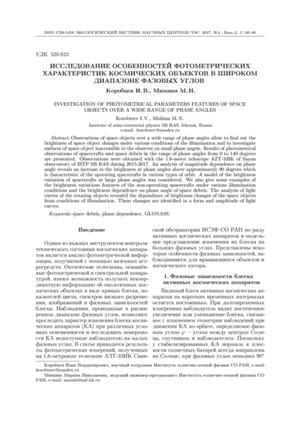Исследование особенностей фотометрических характеристик космических объектов в широком диапазоне фазовых углов
УДК
520.823DOI:
https://doi.org/10.31429/vestnik-14-4-2-60-66Аннотация
Представлены результаты фотометрических наблюдений космических аппаратов и космического мусора в диапазоне фазовых углов от 0° до 140°. Наблюдения были выполнены на 1.6-метровом телескопе АЗТ-33ИК Саянской обсерватории ИСЗФ СО РАН в 2015-2017 гг. Анализ зависимости звездной величины от фазового угла показал возрастание блеска на фазовых углах больших примерно 90°, характерное для действующих космических аппаратов на различных типах орбит. Рассмотрена модель изменения блеска космических аппаратов на больших фазовых углах. Приводятся примеры особенностей изменений блеска пассивных космических аппаратов при различных условиях освещенности и фазовые зависимости блеска космического мусора.
Ключевые слова:
космический мусор, фазовая зависимость, ГЛОНАССБиблиографические ссылки
- Девяткин A.B., Горшанов Д.Л., Куприянов В.В., Верещагина И.А. Программные пакеты "Апекс-I" и "Апекс-II" для обработки астрономических ПЗС-наблюдений // Астрономический вестник. 2010. Т. 50, № 1. С. 74-87. [Devyatkin A.V., Gorshanov D.L., Kupriyanov V.V., Vereshagina I.A. Programmnye pakety "Apeks-I" i "Apeks-II" dlya obrabotki astronomicheskih PZS-nablyudenii ["Apex-I" and "Apex-II" software packages for processing of astronomical CCD observations]. Astronomicheskii vestnik [Solar System Research], 2010, vol. 50, no. 1, pp. 74-87. (In Russian)]
- Cognion R.L. Large Phase Angle Observations of GEO Satellites // Proceedings of SPIE Sensors and Systems for Space Applications VI. 2013. Vol. 8739, 87390K. P. 1-12. DOI: 10.1117/12.2014623
- Cognion R.L. Observations and Modeling of GEO Satellites at Large Phase Angles // Proceeding of the Advanced Maui Optical and Space Surveillance Technologies Conference. Maui HI, USA. 2013. Режим доступа: https://amostech.com/TechnicalPapers/2013/POSTER/COGNION.pdf (дата обращения 20.10.2017).
- Hejduk M.D. Specular and Diffuse Components in Spherical Satellite Photometric Modeling // Proceeding of the Advanced Maui Optical and Space Surveillance Technologies Conference. Maui HI, USA. 2011. Режим доступа: https://www.amostech.com/TechnicalPapers/2011/NROC/HEJDUK.pdf (дата обращения 20.10.2017).
- Scott R., Wallace B. Satellite Characterization using Small Aperture Instruments at DRDC Ottawa // Proceeding of the Advanced Maui Optical and Space Surveillance Technologies Conference. Maui HI, USA. 2008. P. 337-347.
Скачивания

Загрузки
Даты
Поступила в редакцию
Принята к публикации
Публикация
Как цитировать
Лицензия
Copyright (c) 2017 Коробцев И.В., Мишина М.Н.

Это произведение доступно по лицензии Creative Commons «Attribution» («Атрибуция») 4.0 Всемирная.


